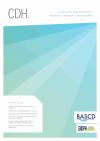Community Dental Health

- Cover Date:
- December 2018
- Print ISSN:
- 0265 539X
- Electronic ISSN:
- 2515-1746
- Vol:
- 35
- Issue:
- 4
Illuminating Mexican migrant adolescents’ dental access and utilization experiences
10.1922/CDH_4255Cabudol07
Objective: To illuminate Mexican migrant adolescents’ dental access and utilization experiences. Research Design: Qualitative focus groups were conducted in English between July 2015 and March 2016 as part of a community-based participatory research project. Participants: Adolescents (n=61) aged 12-19 years, from Mexican migrant worker families, who sought healthcare services at a federally-qualified migrant health clinic in San Diego County, California. Method: Seven focus groups, with different sessions for 12-14, 15-16, and 17-19 year olds. Group size ranged from 4-14. Groups were audio-recorded, transcribed verbatim, then analyzed using content and general thematic
analyses by two researchers using Dedoose qualitative analysis software. Analysis was guided by the Behavioral Model for Vulnerable Populations. Results: Multiple themes emerged: dental fear, difficulty with scheduling dental appointments, competing with family demands, family income and dental tourism, home remedies, lack of direct adolescent-provider communication, and negative dental visit experiences. Adolescents expressed high levels of dental fear and expressed negative dental visit experiences. Cost was a top barrier to care, despite most having dental insurance. Some described seeking dental services and braces in Mexico due to cost. Adolescents wanted providers
to discuss their oral health and treatment needs with them directly as patients, rather than with their parents. Conclusion: Adolescents identified structural and communication barriers that impede access to dental care. Improved patient-provider communication may help build rapport, mitigate dental fear, and facilitate adolescents’ understanding of needed dental treatment and their oral health status. Dental providers may benefit from training to enhance culturally competent communication with Mexican migrant adolescents, and should discuss treatment plans with adolescent patients directly.
Keywords: Adolescents, Oral Health, Dental Utilization, Access to Care, Dental Care, Qualitative, Migrant
- Article Price
- £15.00
- Institution Article Price
- £
- Page Start
- 204
- Page End
- 210
- Authors
- MarkJason Cabudol, Padideh Asgari, Nannette Stamm, Tracy L. Finlayson
Articles from this issue
- Title
- Pg. Start
- Pg. End
- Understanding oral health care needs and oral health-related quality of life in vulnerable adults in Plymouth
- 197
- 200
- A feasibility study to explore the governance processes required for linkage between dental epidemiological, and birth cohort, data in the U.K.
- 201
- 203
- Results of a two year dental health education program to reduce dental caries in young Aboriginal children in New South Wales, Australia
- 211
- 216
- A multi-variable analysis of four factors affecting caries levels among five-year-old children; deprivation, ethnicity, exposure to fluoridated water and geographic region
- 217
- 222
- The impact of age and deprivation on NHS payment claims for domiciliary dental care in England
- 223
- 227
- Why might patients in the UK consult a general medical practitioner when experiencing dental problems? A literature review of patients’ perspectives
- 235
- 240
- Decision tree analysis for factors associated with dental caries in school-aged children in Japan
- 247
- 251
- Dentist’s views on incorporating oral health collaborative practice into primary medical care in Ireland
- 252
- 256
